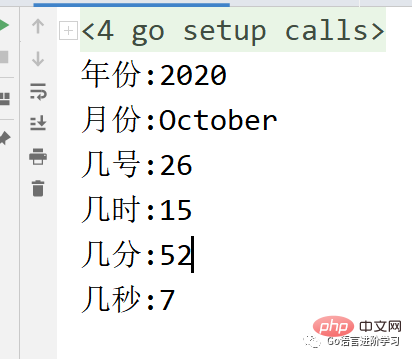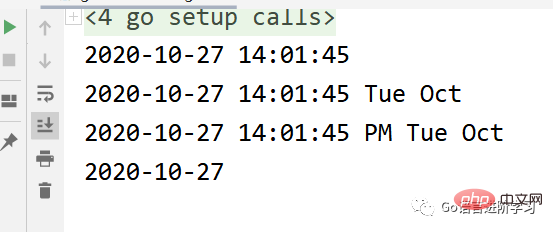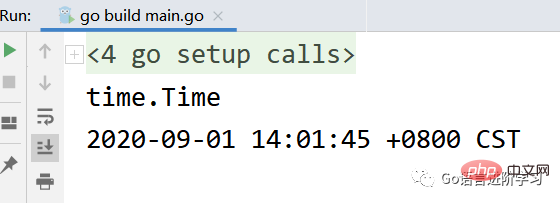Detailed explanation of time package based on Go language
time.Now() returns a Time type.
The relevant codes are as follows
func main() {
var nowTime = time.Now()
fmt.Println(nowTime)
var year = nowTime.Year() //当前年份
var month = nowTime.Month() //当前月份
var day = nowTime.Day() //今天几号
var hour = nowTime.Hour() //现在几时
var Minute = nowTime.Minute() //现在几分
var second = nowTime.Second() //现在几秒
fmt.Printf("当前年份:%v\n",year)
fmt.Printf("当前月份:%v\n",month)
fmt.Printf("几号了:%v\n",day)
fmt.Printf("几时:%v\n",hour)
fmt.Printf("几分:%v\n",Minute)
fmt.Printf("几秒:%v\n",second)
}Execution results

时间戳
时间戳:从北京时间1970年1月1日8点到现在时间的秒数,是一个int64类型。
相关代码
func main() {
var nowTime = time.Now()
var timestampSecond = nowTime.Unix()
fmt.Println(timestampSecond)
}执行结果

到目前为止已经有1603698727秒了,时间不等人呐!
纳秒时间戳
一般情况下我们使用的都是秒,但是时间戳还可以返回成纳秒,用的不多,了解就好。
代码
func main() {
var nowTime = time.Now()
var timestampNano = nowTime.UnixNano()
fmt.Println(timestampNano)
}执行结果

时间戳转Time
有时候别人给我们的是时间戳,我们需要反着转以下,时间戳->时间类型。
需要用到的是time.Unix。
代码
func main() {
//时间戳
var timestampSecond int64 = 1603698727
//转换为time对象
var timeObj = time.Unix(timestampSecond, 0)
var year = timeObj.Year() //当前年份
var month = timeObj.Month() //当前月份
var day = timeObj.Day() //今天几号
var hour = timeObj.Hour() //现在几时
var Minute = timeObj.Minute() //现在几分
var second = timeObj.Second() //现在几秒
fmt.Printf("年份:%v\n", year)
fmt.Printf("月份:%v\n", month)
fmt.Printf("几号:%v\n", day)
fmt.Printf("几时:%v\n", hour)
fmt.Printf("几分:%v\n", Minute)
fmt.Printf("几秒:%v\n", second)
}执行效果

Time
Many times, when we get a time, we need to calculate forward or backward a month, or a few hours, this is time.
In Go, there are two functions for time estimation, one is Add and the other is AddDate, respectively hours and days.
Add
Code
Add最大单位是小时,只能+小时
func main() {
//当前时间
nowTime := time.Now()
fmt.Println("当前时间:",nowTime)
time1 := nowTime.Add(time.Hour)
fmt.Println("加一个小时时间:", time1)
time2 := nowTime.Add( time.Hour*2)
fmt.Println("加二个小时时间:", time2)
}执行结果

AddDate
AddDate就牛逼很多了,有三个参数,分别是年,月,日,根据需求加就行了。
代码
func main() {
//当前时间
nowTime := time.Now()
fmt.Println("当前时间:",nowTime)
month1 := nowTime.AddDate(0, 1, 1)
fmt.Println("加一个月时间:", month1)
month2 := nowTime.AddDate(0, 2, 1)
fmt.Println("加二个月时间:", month2)
}执行结果

注意:上述不仅可以时间+,还可以时间-,前面加负号就可以了。
Sub
Sub通常用在计算某一段代码执行用了多久时间,最后时间-最开始时间=执行时间。
代码
func main() {
//当前时间
beginTime := time.Now()
//各种操作
time.Sleep(time.Second)
//结束时间
end_time := time.Now()
//计算时间
execTime := end_time.Sub(beginTime)
fmt.Println("执行时间:", execTime)
}执行结果

定时器
默认的定时器挺Low的,只有最简单的功能,了解就好。
示例:每隔一秒执行次相关代码。
代码
func main() {
ticker := time.Tick(time.Second)
for i := range ticker {
fmt.Println(i)
}
}执行结果

时间格式化(time -> string)
Go语言的时间格式化,有点逗,跟其他语言都不一样,没有%Y,%M之类的写法。
记住一个时间2006-01-02 15:04:05.000 Mon Jan/PM Mon Jan。
分别对应年-月-日 时:分:秒 24/12。
当前,同其语言一样,可以只格式化年-月-日等。
格式时间需要用到Format方法。
代码
func main() {
now := time.Now()
//年 月 日 时 分 秒
fmt.Println(now.Format("2006-01-02 15:04:05"))
//24小时
fmt.Println(now.Format("2006-01-02 15:04:05 Mon Jan"))
//12小时
fmt.Println(now.Format("2006-01-02 15:04:05 PM Mon Jan"))
//年月日
fmt.Println(now.Format("2006-01-02"))
}执行结果

字符串格式化时间(string -> time)
将拿到的时间字符串转成时间类型。
代码
func main() {
//时间字符串
timeString := "2020/09/01 14:01:45"
//加载时区,亚洲/上海
location, err := time.LoadLocation("Asia/Shanghai")
if err != nil {
fmt.Println("时区加载失败,", err)
return
}
timeObj, err := time.ParseInLocation("2006/01/02 15:04:05", timeString, location)
if err != nil {
fmt.Println("时间转换失败,", err)
return
}
fmt.Println(timeObj)
}执行结果

Summary
This is finally over. The operations on Go time are basically as mentioned above.
Of course, this is a package that comes with so many functions, which is basically enough for daily use.
In fact, the main important ones are Add and AddDate ,Time-> Format String,String-> Time, these are the most frequently used in daily life.
The above is the detailed content of Detailed explanation of time package based on Go language. For more information, please follow other related articles on the PHP Chinese website!

Hot AI Tools

Undresser.AI Undress
AI-powered app for creating realistic nude photos

AI Clothes Remover
Online AI tool for removing clothes from photos.

Undress AI Tool
Undress images for free

Clothoff.io
AI clothes remover

AI Hentai Generator
Generate AI Hentai for free.

Hot Article

Hot Tools

Notepad++7.3.1
Easy-to-use and free code editor

SublimeText3 Chinese version
Chinese version, very easy to use

Zend Studio 13.0.1
Powerful PHP integrated development environment

Dreamweaver CS6
Visual web development tools

SublimeText3 Mac version
God-level code editing software (SublimeText3)

Hot Topics
 How to use reflection to access private fields and methods in golang
May 03, 2024 pm 12:15 PM
How to use reflection to access private fields and methods in golang
May 03, 2024 pm 12:15 PM
You can use reflection to access private fields and methods in Go language: To access private fields: obtain the reflection value of the value through reflect.ValueOf(), then use FieldByName() to obtain the reflection value of the field, and call the String() method to print the value of the field . Call a private method: also obtain the reflection value of the value through reflect.ValueOf(), then use MethodByName() to obtain the reflection value of the method, and finally call the Call() method to execute the method. Practical case: Modify private field values and call private methods through reflection to achieve object control and unit test coverage.
 Tips for dynamically creating new functions in golang functions
Apr 25, 2024 pm 02:39 PM
Tips for dynamically creating new functions in golang functions
Apr 25, 2024 pm 02:39 PM
Go language provides two dynamic function creation technologies: closure and reflection. closures allow access to variables within the closure scope, and reflection can create new functions using the FuncOf function. These technologies are useful in customizing HTTP routers, implementing highly customizable systems, and building pluggable components.
 The difference between performance testing and unit testing in Go language
May 08, 2024 pm 03:09 PM
The difference between performance testing and unit testing in Go language
May 08, 2024 pm 03:09 PM
Performance tests evaluate an application's performance under different loads, while unit tests verify the correctness of a single unit of code. Performance testing focuses on measuring response time and throughput, while unit testing focuses on function output and code coverage. Performance tests simulate real-world environments with high load and concurrency, while unit tests run under low load and serial conditions. The goal of performance testing is to identify performance bottlenecks and optimize the application, while the goal of unit testing is to ensure code correctness and robustness.
 What pitfalls should we pay attention to when designing distributed systems with Golang technology?
May 07, 2024 pm 12:39 PM
What pitfalls should we pay attention to when designing distributed systems with Golang technology?
May 07, 2024 pm 12:39 PM
Pitfalls in Go Language When Designing Distributed Systems Go is a popular language used for developing distributed systems. However, there are some pitfalls to be aware of when using Go, which can undermine the robustness, performance, and correctness of your system. This article will explore some common pitfalls and provide practical examples on how to avoid them. 1. Overuse of concurrency Go is a concurrency language that encourages developers to use goroutines to increase parallelism. However, excessive use of concurrency can lead to system instability because too many goroutines compete for resources and cause context switching overhead. Practical case: Excessive use of concurrency leads to service response delays and resource competition, which manifests as high CPU utilization and high garbage collection overhead.
 Golang technology libraries and tools used in machine learning
May 08, 2024 pm 09:42 PM
Golang technology libraries and tools used in machine learning
May 08, 2024 pm 09:42 PM
Libraries and tools for machine learning in the Go language include: TensorFlow: a popular machine learning library that provides tools for building, training, and deploying models. GoLearn: A series of classification, regression and clustering algorithms. Gonum: A scientific computing library that provides matrix operations and linear algebra functions.
 Can golang variable parameters be used for function return values?
Apr 29, 2024 am 11:33 AM
Can golang variable parameters be used for function return values?
Apr 29, 2024 am 11:33 AM
In Go language, variable parameters cannot be used as function return values because the return value of the function must be of a fixed type. Variadics are of unspecified type and therefore cannot be used as return values.
 The evolution of golang function naming convention
May 01, 2024 pm 03:24 PM
The evolution of golang function naming convention
May 01, 2024 pm 03:24 PM
The evolution of Golang function naming convention is as follows: Early stage (Go1.0): There is no formal convention and camel naming is used. Underscore convention (Go1.5): Exported functions start with a capital letter and are prefixed with an underscore. Factory function convention (Go1.13): Functions that create new objects are represented by the "New" prefix.
 The role of Golang technology in mobile IoT development
May 09, 2024 pm 03:51 PM
The role of Golang technology in mobile IoT development
May 09, 2024 pm 03:51 PM
With its high concurrency, efficiency and cross-platform nature, Go language has become an ideal choice for mobile Internet of Things (IoT) application development. Go's concurrency model achieves a high degree of concurrency through goroutines (lightweight coroutines), which is suitable for handling a large number of IoT devices connected at the same time. Go's low resource consumption helps run applications efficiently on mobile devices with limited computing and storage. Additionally, Go’s cross-platform support enables IoT applications to be easily deployed on a variety of mobile devices. The practical case demonstrates using Go to build a BLE temperature sensor application, communicating with the sensor through BLE and processing incoming data to read and display temperature readings.






